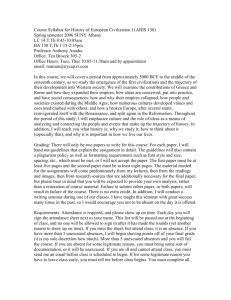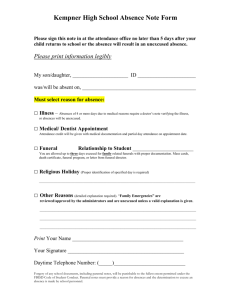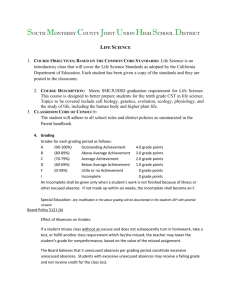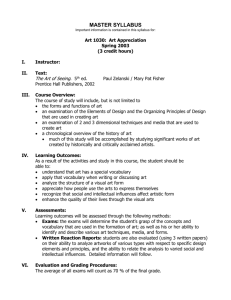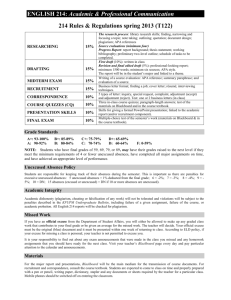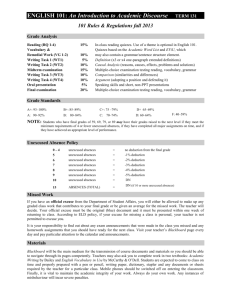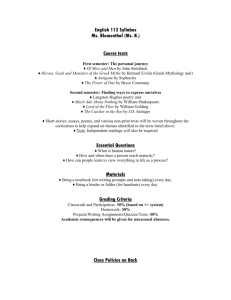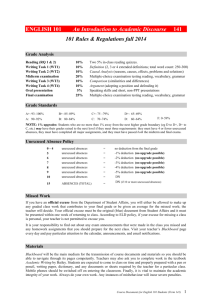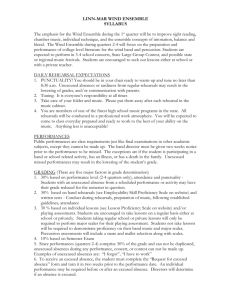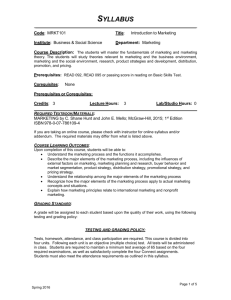Greenfield High School
advertisement
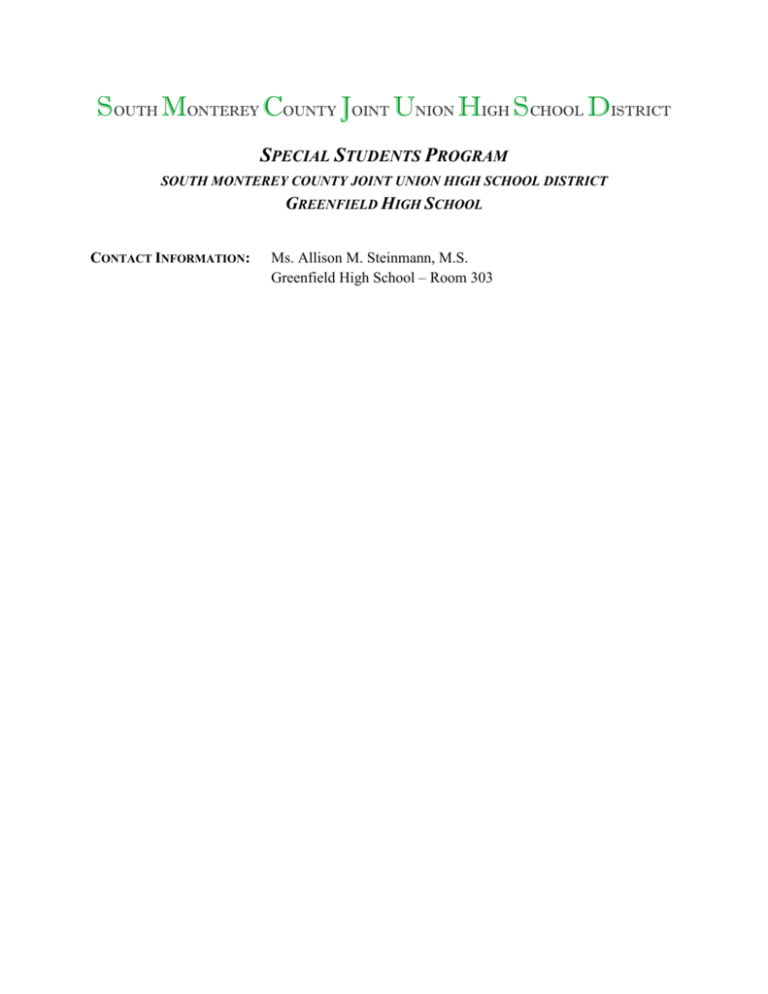
SOUTH MONTEREY COUNTY JOINT UNION HIGH SCHOOL DISTRICT SPECIAL STUDENTS PROGRAM SOUTH MONTEREY COUNTY JOINT UNION HIGH SCHOOL DISTRICT GREENFIELD HIGH SCHOOL CONTACT INFORMATION: Ms. Allison M. Steinmann, M.S. Greenfield High School – Room 303 (831) 674-2751 ext. 1306 asteinmann@kigncity.k12.ca.us STANDARDS-BASED COURSE OBJECTIVES: The Special Students Program is committed to providing a supportive environment in which students with disabilities can develop intellectual, academic, physical, social, emotional and civic life skills. The department strives to assist each student to successfully access the rich variety of learning opportunities provided by Greenfield High school courses, services and extra-curricular activities. The Special Students Program supports each student's efforts to become a self-aware, self-advocating, self-directed strategic learner. The Special Education courses provide specialized special education instruction and support to eligible students. Eligibility is determined by a multidisciplinary team of professionals including the student, parents and staff. The identification, placement and provision of special education programs and services are governed by both state and federal regulation. Courses are designed to meet individual learner needs and address any exceptional characteristics which interfere with learning. Each eligible student has a written Individual Education Plan (IEP) that specifies goals and short term objectives and their instructional and related services. Any parent, staff member or student may request a referral for identifying potential special education needs. COURSE DESCRIPTION: APPLIED LEARNING MISSION STATEMENT The mission of the Applied Learning Program in the Special Students Program at Greenfield High School is to provide a safe, positive environment in which students can experience a challenging academic program and transition opportunities to meet their individual needs. The students in this program have moderate and severe disabilities. The focus is on appropriate academic/life skill classes with support, social support throughout the school day and intensive transition planning in order to prepare for and bridge the gap between high school and post-secondary education and life skills. SSP PROGRAM – The Special Students Program at Greenfield High School is designed for students who have an Individual Education Plan (IEP) and are recommended for this alternative academic setting. Every student in SSP will participate in a full day, self-contained program with options for partial Mainstream/Inclusive learning in the General Education learning settings. The goal with the curriculum, therapeutic support, and behavior management is to help the students develop the skills needed to succeed in school both academically and socially. Subject Curriculum TRANSITIONAL ENGLISH — The English Language curriculum includes Edmark Reading/Word Decoding, Sitton Spelling, Lakeshore curriculum and additional resources which are individually structured to improve each student’s listening, reading, speaking and writing skills. There is a word – decoding reading skill, reading comprehension and sight word skill development, as well as vocabulary, grammar and mechanics. The English Language development strives to enhance Site Word skills used in daily job and life skill settings. CONSUMER MATH — PCI, Touch Math and Lakeshore Mathematic curriculum including Mathematic Calculations, Mathematic Applications, Money Mathematics, Time/Calendar Mathematics, and additional Mathematics equations that support everyday life skills. This is instruction will provide students with the everyday math skills needed to succeed in life. SOCIAL ACADEMIC LEARNING - This curriculum provides a positive structured program for students who have experienced difficulty in educational, social, and emotional areas. The SAL's goal is to provide a structure of expectations that effectively balances both positive and negative consequences, as it guides students toward the completion of requirements for their high school graduation and prepares them for appropriate post high school options. TRANSITION — Transition curriculum include Community Based Instruction and Community Job Learning opportunities. The topics covered would include: college/career exploration, structured employment applications/resume/ financial literacy, and selfadvocacy – knowing your disability, resources available, and other topics. APPLIED COMMUNICATION –This pre-vocational course provides students with an opportunity to expand pragmatic language and communication skills while exploring postsecondary career and education options. Students engage in active and field based learning situations, which require them to apply and expand receptive and expressive verbal communication skills. Included is their practical knowledge in the areas of careers, education, career training, math, money, time, maps and related vocabulary. The correct use of appropriate language is stressed in vocationally relevant situations. 3. CLASSROOM CODE OF CONDUCT: Behavioral expectations The student will adhere to all school rules and district policies as summarized in the Parent handbook. GRADING SCALE: Administrative Regulation (AR) 5121 (a) Grades for each grading period as follows: A (90-100%) Outstanding Achievement 4.0 grade points B (80-89%) Above Average Achievement 3.0 grade points C (70-79%) Average Achievement 2.0 grade points D (60-69%) Below Average Achievement 1.0 grade points F (0-59%) Little or no Achievement 0 grade points An Incomplete shall be given only when a student’s work is not finished because of illness or other excused absence. If not made up within six weeks, the Incomplete shall become an F. Board Policy 5121 (b) Effect of Absences on Grades: If a student misses class without an excuse and does not subsequently turn in homework, take a test, or fulfill another class requirement which he/she missed, the teacher may lower the student’s grade for nonperformance, based on the value of the missed assignment. The Board believes that 5 unexcused absences per grading period constitute excessive unexcused absences. Students with excessive unexcused absences may receive a failing grade and not receive credit for the class(es). Students and parents/guardians shall be informed by the teachers if class credit is withheld due to excessive unexcused absences. Each time an unexcused absence occurs the student and parent/guardian shall again be notified of the district’s policy regarding excessive unexcused absences. When a student has 4 unexcused absences a phone call and/or meeting will be arranged by the teacher with the parent/guardian. 4. ASSESSMENTS/ASSIGNMENTS: Currently planned, but subject to change based on the needs of the students. This might be the most pertinent area for parents and students. Though, oftentimes, teachers modify assignments based on the needs of the class, a list of potential assignments and their contribution to the student’s grade generally serves as a platform for parents to hold their student accountable. It is the primary way to entice proactive parent involvement and discourage academic apathy. 5. SPECIAL CIRCUMSTANCES: Address how the teacher will handle, a. Late or missing work b. Plagiarism and cheating 6. CLASS EXPECTATIONS – ALL STUDENTS WILL STRIVE TO LEARN, DEVELOP AND ACQUIRE LIFELONG SKILLS IN FUNCTIONAL LIFE SKILLS, FUNCTIONAL ACADEMIC SKILLS, AND REACH THE GOALS AND OBJECTIVES OF INDIVIDUAL EDUCATION PLANS DESIGNED FOR AND WITH EACH STUDENT. STUDENTS DEVELOP SKILLS TO ENHANCE THEIR SOCIAL AND COGNITIVE LEVELS TO TRANSITION TO POST-SECONDARY EDUCATION AND JOB SKILL DEVELOPMENT PROGRAMS. (Effective 8/20/2013)
